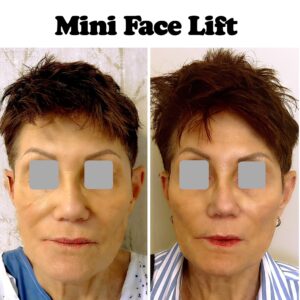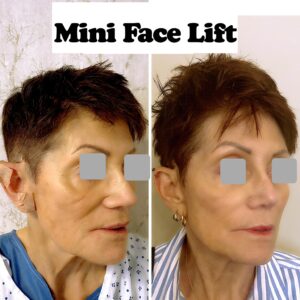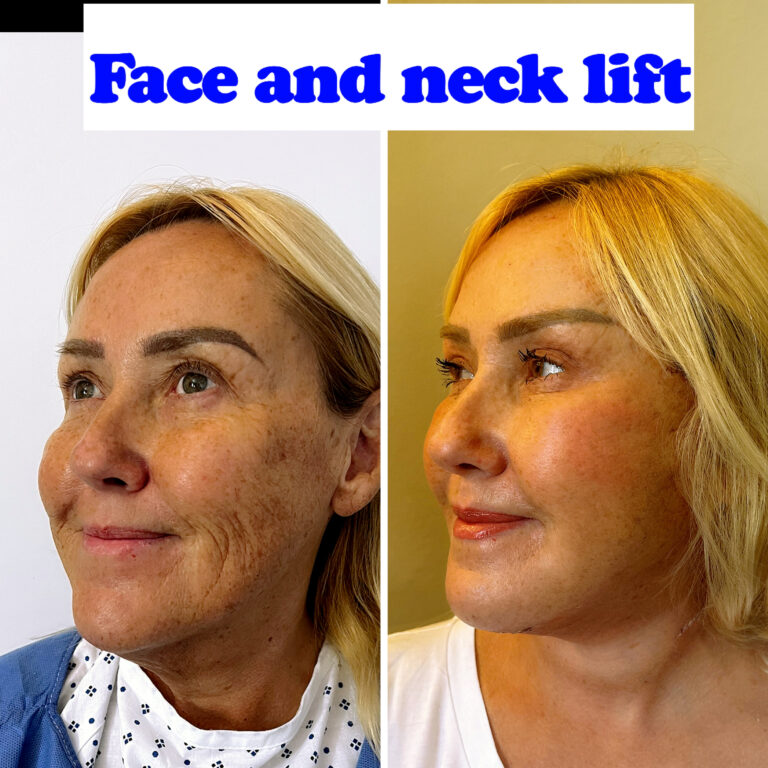
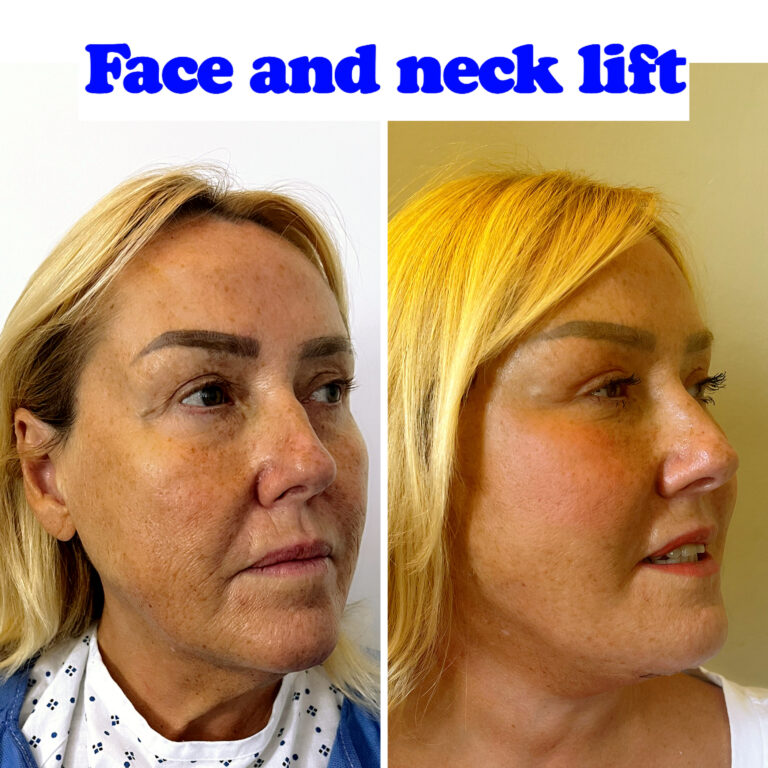
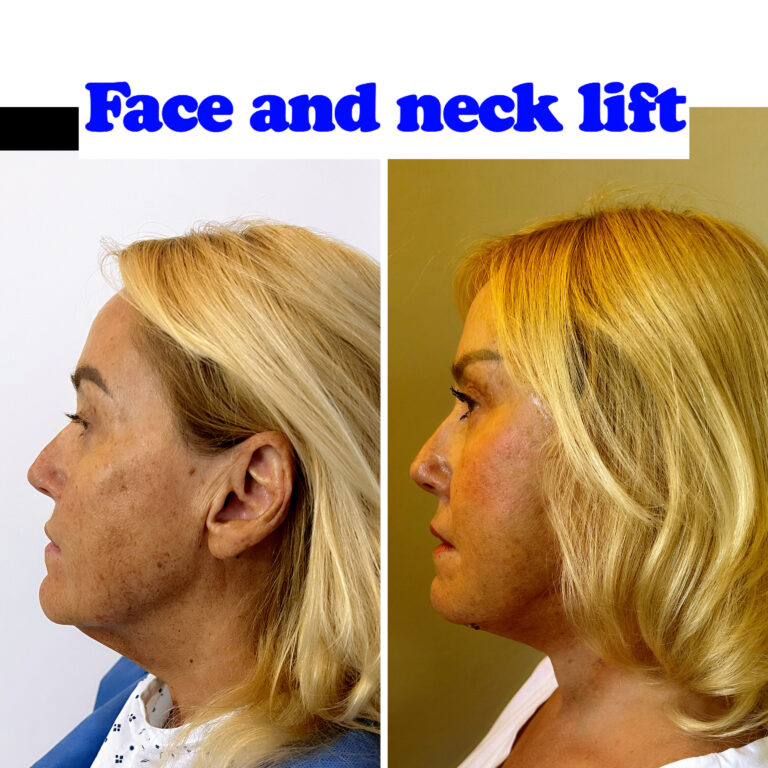
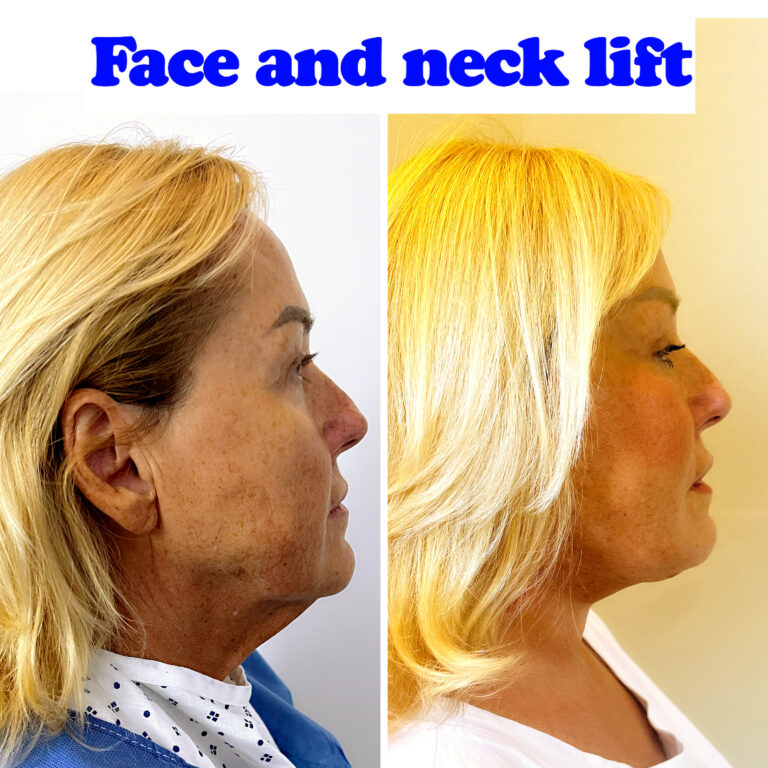


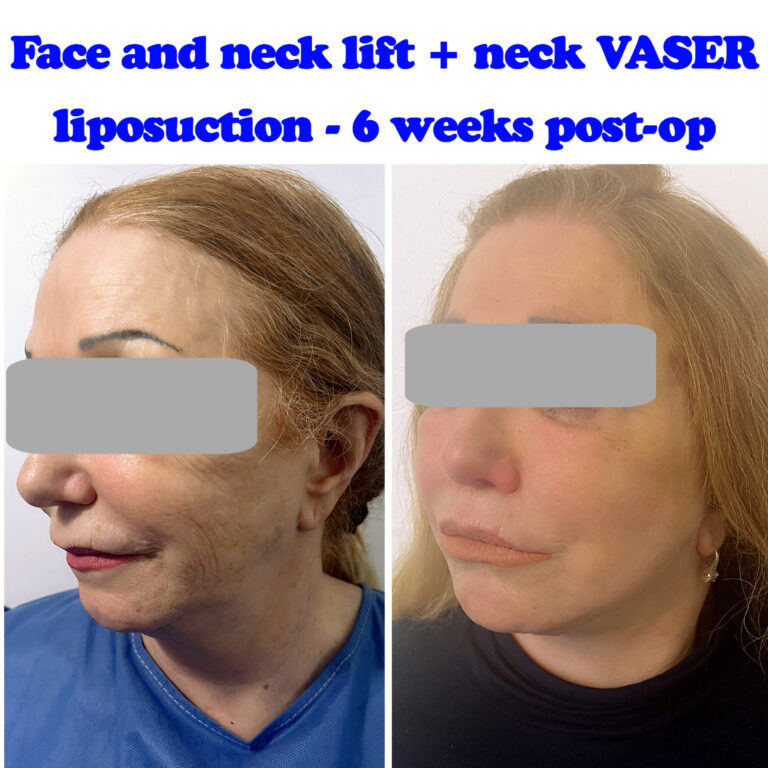
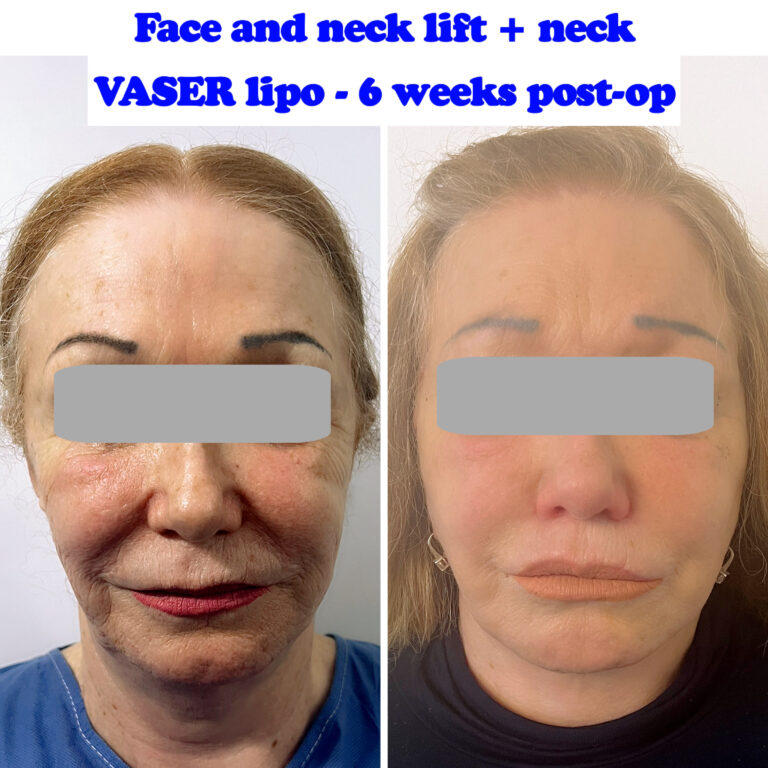
The ageing process is something that happens to all of us sooner or later. Gravity, stress, and sun exposure can all take their toll on your face and neck. Your smile lines can deepen, jawline sag, and neck can become loose. Your skin doesn’t necessarily reflect your age, as multiple factors can impact how your face and neck appear.
A facelift and neck lift can help combat the signs of ageing and improve some of the most visible signs of ageing from unwanted wrinkles or sagging skin. As you age, the skin begins to lose elasticity, it’s more prone to sagging, and wrinkles to start to form. These signs of ageing are especially visible on the neck and face. Unfortunately, no-one can escape the ageing process altogether. But many people opt to have a facelift and neck lift to reverse the clock and improve their appearance.
Facelift and Neck Lift: Quick Overview
- Surgery Time: 2-4 hours
- Anaesthetic: General
- Hospital Stay: Same-day
- Dressing and Garments: 2 weeks
- Time Off Work: 2 weeks
- Exercise: 6 Weeks
- Mobile: 1 day
- Washing: 48 hours
- Sleeping Position: On your back with head slightly elevated for 2 weeks
- Full Recovery: 6 weeks
What Happens During a Facelift and Neck Lift?
Firstly, a facelift tightens and lifts the skin below the eye. If you’re looking to lift anything above the eyes, you would need to consider a brow lift. During a facelift, your surgeon will lift and reposition the skin and soft tissue of the face. A facelift takes around 2 hours to perform.
During the procedure, your surgeon will tighten the underlying muscle and lift the skin from the face. They will then reposition the skin and remove any excess skin. The sutures that hold the skin in place are at the hairline to keep any scarring to an absolute minimum.
There are a few different types of facelift surgery, depending on the results you’re looking to achieve.
Traditional Facelift
A traditional facelift involves your surgeon making an incision along the hairline, down past the front of the ears to behind the ears. Your scars will be in your hairline and in the natural creases of the face. Next, the skin is separated from the underlying tissue. Excess fat is then repositioned, and the muscles tightened. The facial skin is then lifted and repositioned with any excess skin removed. Your face is then wrapped in bandages and sometimes drains are used to drain excess fluids.
Minimal-Access Cranial Suspension (MACS)
This procedure is similar to a traditional facelift but uses much smaller incisions. Your surgeon will tighten and reposition the skin through these small incisions.
Keyhole Surgery
Keyhole surgery uses small incisions to feed a telescopic camera underneath the skin. From this, your surgeon will be able to see which muscles to tighten and where to remove fat. The benefit of keyhole surgery is that it requires less surgery and recovery time as well as less scarring.
Neck Lift
A neck lift, as you can imagine, lifts and tightens the skin on the neck. During a neck lift, your surgeon will remove excess skin and fat from underneath the chin. You can also remove lines and skins from around the neck by tightening the neck muscles through very small incisions. If needed, your surgeon may use liposuction on the neck as well.
When you combine a facelift and neck lift, the neck muscle and skin is tightened and stitched to structures in front and behind the ear. At this time, excess skin is also removed.
Although you can do both procedures individually, it’s normal to include both treatments simultaneously for a whole rejuvenating package.
Before and After Facelift and Neck Lift
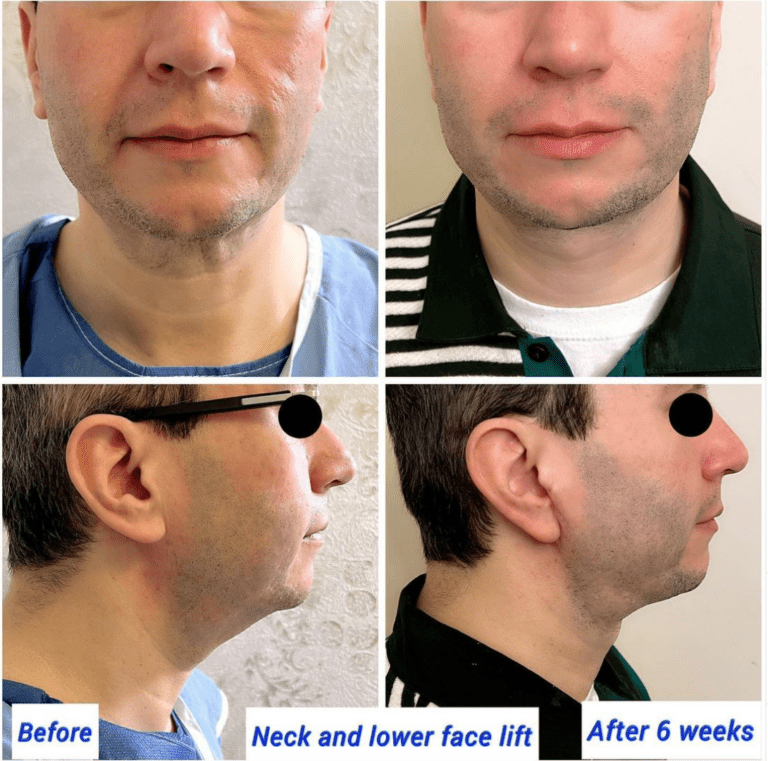
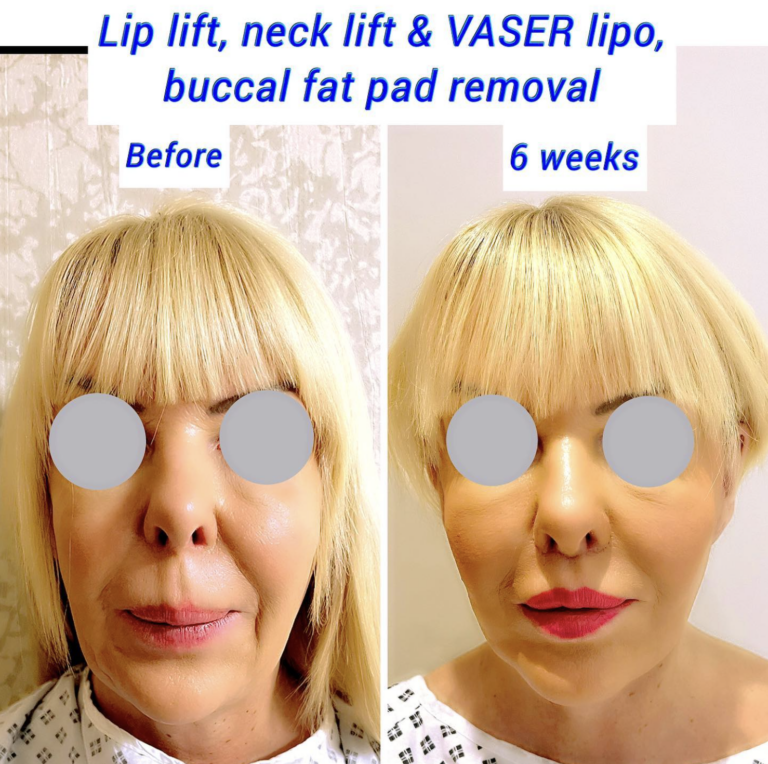
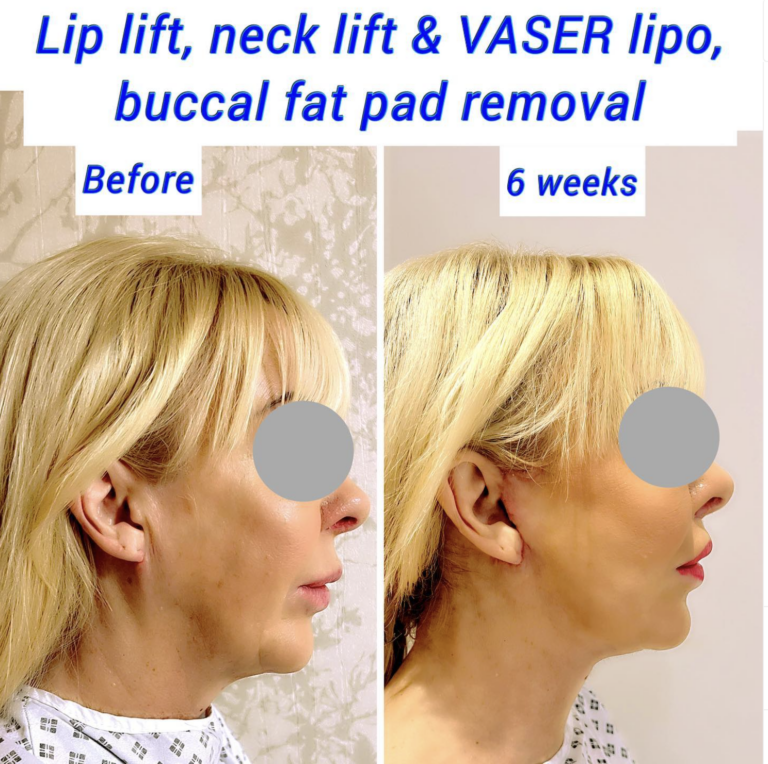
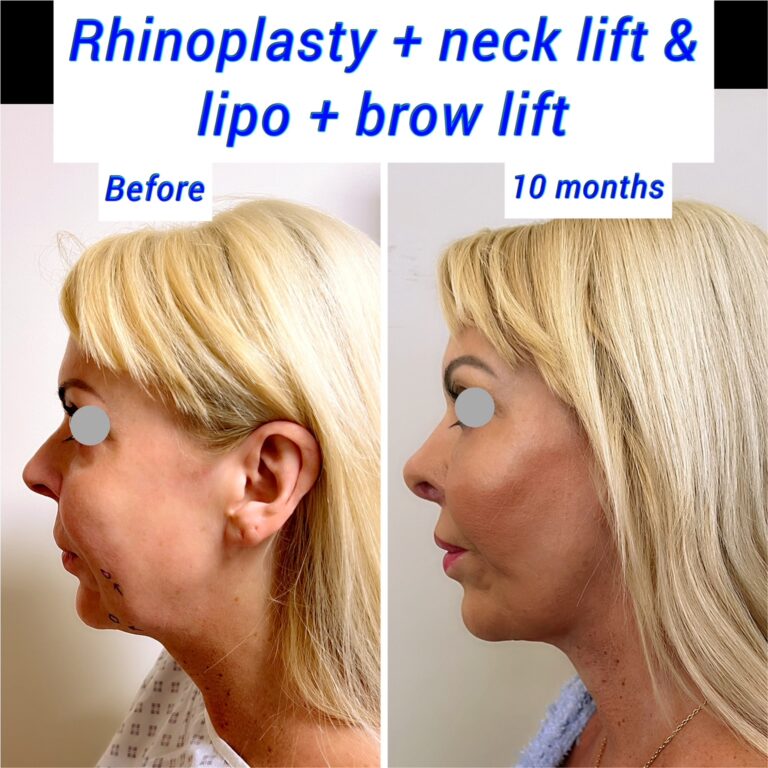
Why Have a Facelift and Neck Lift?
You might consider a facelift and neck lift for the following reasons:
- Loose skin in the neck area
- Loose skin around the face
- Want to look younger
- Loss substantial weight and left with excess skin
- Deep lines in the corner of the mouth
- Visible jowls
What Happens During Your Consultation?
During your consultation, you will discuss with your surgeon what you’re looking to achieve. They will talk you through every aspect of the procedure and go through a medical assessment. You will discuss your medical history. Your surgeon will examine your face and neck and take photos for medical records. After measuring your height and weight, they will determine if it is safe for the surgery to go ahead.
What are the Benefits of a Facelift and Neck Lift?
The neck is usually one of the first parts of the body to show signs of ageing. The skin on the neck is thinner, so it tends to lose elasticity faster. By undergoing a facelift and neck lift, it can result in a physical transformation that can take years off.
The primary benefits of the two treatments focus on turning back the clock. It helps you to achieve a more youthful appearance. Other benefits include:
- Shed excess skin from the neck and jawline.
- Tighten up sagging skin.
- Redefine the jawline.
- Get rid of deep creases.

Is a Facelift and Neck Lift Permanent?
You should see the final result of your procedure in 6-9 months. The results of a facelift and neck lift usually last between 5-10 years. This type of procedure doesn’t stop the ageing process, but you will look younger for years to come.
Will Your Facelift Look Natural?
Yes, when performed correctly by a skilled surgeon, your facelift will look natural. The aim is always to look natural with a rejuvenated, more youthful appearance.
What Will Your Facelift and Neck Scars Be Like?
With a neck lift, the scars will be behind the ears and under the chin in most cases. Scars from a facelift are typically concealed in the hairline.
Can You Have a Facelift if You Have Already Had One?
Some people do seek another facelift after having one. Usually, it can take place after approximately 10 years. Some people get another facelift is as little as 5 years after their previous one.
8 Expert Tips to Prepare for Your Facelift
1. Quit Smoking
Nicotine restricts the blood flow and can increase the risk of complications during surgery. Any type of nicotine is off-limits in the run-up to your surgery. Smoking can also make your skin look older and more wrinkled.
2. Meal Prep
It’s a good idea to make healthy food choices before and after your surgery. To give yourself the best chance to recover, meal prep some healthy meals for after your facelift. You need to have ample rest, and this helps to take the hassle out of cooking.
3. Share Your Medical History
Make sure you share your medical history with your plastic surgeon. Discuss any current medications and medical history so that you can get the best and most relevant advice.
4. Maintain Healthy Habits
Follow a healthy diet and exercise regularly. As with any cosmetic treatment, you should be in good health before surgery to achieve the best results.
5. Discuss Your Expectations
Your plastic surgeon should give you a realistic expectation of what you can expect from your surgery. It’s important to have this conversation so that you can prepare for the outcome.
6. Avoid Alcohol
In general, you should avoid drinking alcohol five days before your surgery. While you may want a glass of wine to calm the nerves, alcohol can thin the blood and increase the risk of excessive bleeding during surgery.
7. Follow Your Surgeon’s Instructions
Your plastic surgeon is an expert in cosmetic treatments. A thorough assessment and consultation mean they can give you the best instructions to prepare for your surgery. It’s essential that you follow the pre and post-op preparation and recovery instructions.
8. Arrange Help
Before your facelift, arrange help from a partner, family member or friend. This will include driving you home from the procedure and staying with you for the first few days while you recover.
By preparing mentally and physically for your facelift, you can put yourself in the strongest position to allow your body to recover and achieve the safest and best results possible.

How Long Does it Take to Recover From a Facelift and Neck Lift?
The initial recovery period usually takes around 2 weeks. In the first few days, you will feel some tenderness. Any bruising and swelling will be at their worst around day 2. After 5-10 days, your surgeon will remove the sutures. After you get the all-clear, you can expect to resume rigorous activity in 4 weeks. Most patients see the final results in 3 months, but you will continue to heal for 6 months following your procedure.
Here’s what to expect after your facelift surgery.
Immediately following the procedure, expect to look worse before you look better. You will experience some swelling and bruising. But, as the bruising fades, you will start to see results. After your procedure, your head will be bandaged. The bandages are usually removed about 1 day after your surgery. Once your bandages are off, you can shower. It’s essential that you keep calm and rest during your recovery. Here is a breakdown of the recovery timeline:
1-3 days – there will be some discomfort but not significant pain.
1 week – you will be starting to feel more normal and be a little more active around the house. You can do light exercise like walking, but nothing strenuous. You should be able to drive by this point.
2 weeks – by now, you are over the biggest part of the recovery. You can return to work, and many patients go outside at this time.
1 month – you will almost be over your recovery. You can resume normal activities like strenuous exercise. You still need to be careful, though. Most of the bruising and swelling should have subsided.
2+ months – all the side effects should be gone, and you will be starting to enjoy your new face. There should be no signing of bruising or visible incisions.
6 Facelift and Neck Lift Aftercare Tips
To help you make the most of your recovery, here are six plastic surgeon-approved tips to achieve the best results.
1. Keep Your Head Elevated
To minimise swelling and bruising, keep your head elevated in the first few days following your surgery.
2. Don’t Wear Makeup for One Week
Give yourself one week before applying any makeup. Although it’s tempting to apply makeup to cover up any bruising, it’s best to avoid makeup for one week.
3. Avoid the Sun
Avoid direct sun exposure during the healing process, as this can be harmful to your skin.
4. Stay Hydrated and Eat Well
Follow a healthy diet and stay hydrated during your recovery to give your body the best opportunity to heal.
5. Wait Before Your First Facial
It’s best to wait at least three months before you get your first facial. This gives you enough time for any bruising and swelling to go down beforehand.
6. Take it Easy
Remember to take it easy and get plenty of rest. Try to move just a little as soon as you can after your surgery. A walk in the garden or around the bedroom is fine.
The main facelift recovery period is about 2 weeks. This is when it has the most impact on your life, and you need to take active steps to heal. By following your surgeon’s post-recovery guidelines and sticking to our expert tips, you can promote healing and make yourself as comfortable as possible.

Who is the Ideal Candidate for a Facelift and Neck Lift Surgery?
As with any surgery, the choice to undergo a facelift and neck lift is a personal one. But if you’re wondering who is the ideal client for the procedure, the following qualities are usually taken into consideration:
- In good physical health
- Non-smoker
- No extensive sun damage on facial skin
- Realistic expectations
Are There Alternative Treatments?
A face and neck lift tightens the skin around the face and neck. However, it doesn’t specifically tackle wrinkles. If you’re particularly concerned with wrinkles, alternative treatments include botulinum toxin, chemical peels, and lipofilling.
What are the Potential Risks and Complications of a Facelift and Neck Lift?
If you’re thinking about getting any type of plastic surgery, there will be risks. The potential risks and complications of a facelift and neck lift are:
- Infection
- Bleeding
- Hematoma
- Anaesthesia risks
- Skin and or fat/necrosis
- Fluid accumulation
- Pain
- Swelling
- Poor wound healing
- Poor scarring
- Nerve injury
- Contour irregularity
- Seroma
- Over/under correction
- Asymmetry
- Damage to other structures
- DVT
- PE
- Chest infection
If you’re looking to turn back the clock and really define your jawline and neck, this treatment may be ideal. Sagging skin and deepening creases can make you feel and look older than you are. If your main aim is to lift, tighten, and brighten, a facelift and neck lift could be just right for you.
To book a consultation today, please call 0203 582 4947 or email [email protected].
Further Reading:
- Your Facelift Recovery Guide
- How to Care for Your Skin After a Facelift
- Facelift and Neck Lift: Everything You Need to Know
- Preparing for Your Facelift: 8 Expert Tips
- How to Wash Your Hair After a Facelift
- 5 Best Tips to Maintain Your Facelift Results
- Is a Mini Facelift Right For You?
- What is The Best Age to Get A Facelift?
- Should You Get a Mini or Full Facelift?
- What is a Mid Facelift?
- Facelift for Men: Here’s What You Need To Know











